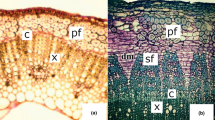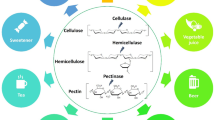Summary
Three wood-destroying fungi of the white-root type, Ganoderma resinaceum, Ganoderma pfeifferi and Ganoderma lucidum are tested in their cellulolytic activity.
Ganoderma resinaceum and Ganoderma pfeifferi produce an extracellular enzyme system, that degrade Carboxymethylcellulose and insoluble cellulose powder.
Ganoderma lucidum degrades Carboxymethylcellulose in a very small extent and only in presence of organic nitrogen sources; cellulose powder was not attacked.
Zusammenfassung
Ganoderma resinaceum und Ganoderma pfeifferi verfügen über ein Enzymsystem, das Carboxymethylcellulose und Cellulosepulver anzugreifen vermag; beide Pilze dürfen danach als cellulolytisch aktiv bezeichnet werden.
Ganoderma lucidum erweist sich dagegen als cellulolytisch inaktiv. Carboxymethylcellulose wird nur in verschwindend geringer Menge abgebaut und dies nur in Verbindung mit einer organischen N-Quelle; Cellulosepulver wird überhaupt nicht angegriffen.
Similar content being viewed by others
Literatur
Campbell, W. G.: The chemistry of the white roots of wood. I. The effect on wood substance of Polyporus versicolor. Biochem. J. 24, 1235 (1930).
—: The chemistry of the white roots of wood. II. The effect on wood substance of Armillaria mellea (Vahl) Fr., Polyporus hispidus (Bull) Fr. and Stereum hirsutum Fr. Biochem. J. 25, 2023 (1931).
—: The chemistry of the white roots of wood. III. The effect on wood substance of Ganoderma applanatum (Pers.) Pat., Fomes fomentarium (Linn) Fr., Polyporus adustus (Willd.) Fr., Trametes pini (Brot.) Fr. and Polyporus abietus (Dick) Fr. Biochem. J. 26, 1829, 1938 (1932).
Gascoigne, J. A., and M. Gascoigne: Biological degradation of cellulose, p. 215. London: Butterworth 1960.
Haliwell, G.: In: Advances in enzymic hydrolysis of cellulose and related materials, pp. 71–79 (ed. by E. T. Reese). Oxford-London-New York: Pergamon Press 1963.
Husemann, E., u. M. Lötterle: Über den fermentativen Abbau von Polysacchariden. I. Der heterogene Abbau von Cellulose. Makromol. Chem. 4, 278 (1950).
Jahn, H.: Westf. Pilzbriefe, Bd. IV, S. 31. Eigen-Verl. 1963.
King, K. W.: In: Advances in enzymic hydrolysis of cellulose and related materials, pp. 159–170 (ed. by E. T. Reese). Oxford-London-New York: Pergamon Press 1963.
Kreisel, H.: Die phytopathogenen Großpilze Deutschlands. Jena: VEB Fischer 1961.
Nisizawa, K., Y. Hashimoto, and Y. Shibata: In: Advances in enzymic hydrolysis of cellulose and related materials, pp. 171–184 (ed. by E. T. Reese). Oxford-London-New York: Pergamon Press 1963.
Petterson, G., and J. Porath: Studies on cellulolytic enzymes. II. Multiplicity of the cellulolytic enzymes of Polyporus versicolor. Biochim. biophys. Acta (Amst.) 67, 9 (1963).
Reese, E. T.: Enzymatic hydrolysis of cellulose. Appl. Microbiol. 4, 39 (1956).
—, and H. S. Levinson: A comparative study of the breakdown of cellulose by microorganisms. Physiol. Plant. (Copenh.) 5, 345 (1952).
—, and H. S. Levinson: The biological degradation of soluble cellulose derivates and its relationship to the mechanism of cellulose hydrolysis. J. Bact. 59, 435 (1950).
Rypacek, V.: Biologie holzzerstörender Pilze. Jena: VEB G. Fischer 1966.
Selby, K.: In: Advances in enzymic hydrolysis of cellulose and related materials, pp. 33–39 (ed. by E. T. Reese). Oxford-London-New York: Pergamon Press 1965.
Sison, B. C., W. J. Schubert, and F. F. Nord: On the mechanism of enzyme action. LXV: A cellulolytic enzyme from the mold Poria vaillantii. Arch. Biochem. 75, 260 (1958).
Whitacker, D. R.: Hydrolysis of a series of β-1,4-oligo-glucosides by Myrothecium verrucaria cellulase. Arch. Biochem. 43, 253 (1953).
—: The mechanism of degradation of cellulose by Myrothecium cellulase. Canad. J. Biochem. Physiol. 35, 733 (1957).
Author information
Authors and Affiliations
Rights and permissions
About this article
Cite this article
Walch, H., Kühlwein, H. Zur Kenntnis der cellulolytischen Aktivität in der Gattung Ganoderma (Lackporlinge). Archiv. Mikrobiol. 61, 373–380 (1968). https://doi.org/10.1007/BF00409673
Received:
Issue Date:
DOI: https://doi.org/10.1007/BF00409673




